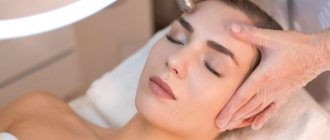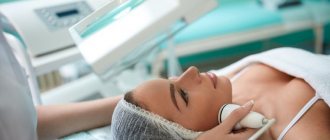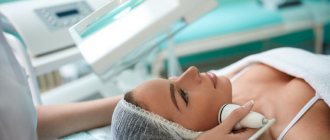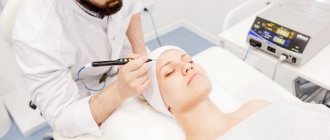Elimination of skin defects using a laser is a safe, painless and strictly controlled procedure for evaporation of the upper layer of the epidermis. CO2 laser resurfacing does not violate the protective properties of the skin, since the beam penetrates to a depth of less than 3 mm. The effect is noticeable after 15–30 days.
Laser resurfacing with a CO2 laser gives the face a fresh and healthy look. Laser energy penetrates the epidermis and dermis, causes microdamage to the surface layers and stimulates the production of collagen and elastin. The launched regeneration process ends with the formation of new cells and an increase in the content of hyaluronic acid in the skin.
Price
| Full face (without eyelids) | RUB 22,550 |
| Full face (without eyelids), double zonal polishing on problem areas | RUB 25,300 |
| Face+eyelids | RUB 28,100 |
| Face+eyelids+neck | RUB 32,450 |
| Forehead | RUB 7,150 |
| Chin | RUB 6,900 |
| Neck (cervical-mental angle) (front) | RUB 9,570 |
| Face + neck (cervicomental angle) | RUB 28,600 |
| Upper eyelids | RUB 6,700 |
| Suture of the upper eyelids after blepharoplasty | RUB 3,700 |
| Lower eyelids | RUB 6,700 |
| Upper+lower eyelids | RUB 10,600 |
| Nose area | RUB 7,150 |
| Cheeks (both) | RUB 15,400 |
| Cheeks (both) double grinding in problem areas | RUB 17,490 |
| Neckline area | RUB 16,500 |
| Laser breast resurfacing | RUB 19,800 |
| Areolas (both) | RUB 6,050 |
| Laser resurfacing of seams after vertical breast lift | RUB 9,350 |
| Laser resurfacing of seams after anchored breast lift | RUB 11,550 |
| laser resurfacing of seams after abdominal lift (stomach) | RUB 15,950 |
| Hands | RUB 9,790 |
| Face+eyelids+neck+décolleté | RUB 39,600 |
| Back | RUB 42,100 |
| Shoulders | RUB 28,600 |
| Buttocks area | RUB 20,900 |
| Hip area (both) | RUB 28,600 |
| Side area | RUB 16,500 |
| Stomach | RUB 21,450 |
| Scar, scar beyond 1 cm (sq.) | RUB 1,650 |
| Scar, scar for 1 sq. cm (double grinding along the scar) | RUB 1,850 |
| Anesthesia (application) small zone | 500 rub |
| Anesthesia (application) large area | 1 thousand rubles |
Sign up for a consultation
CO2 laser skin resurfacing
CO2 laser skin resurfacing is a procedure that uses carbon dioxide (CO2) and a laser to remove scars, warts, stretch marks and deep wrinkles. Using this method, you can reduce the appearance of several signs of aging and get rid of some other imperfections.
The device uses intense light power to treat many aesthetic problems. Drooping bags under the eyes, acne scars and age spots are some of the most common problems that are addressed to cosmetology centers in Moscow and other cities. The procedure has a fairly high price, but if used correctly, this type of hardware intervention can significantly delay the need for surgical intervention.
Up to 1,000,000 rubles
Fractional carbon dioxide lasers in the price segment up to 1 million rubles are inferior to top models in functionality and procedural results. As a rule, these devices do not operate in super-pulse mode.
TOP Laser CO2-1A
The TOP Laser CO2-1A device is designed for fractional rejuvenation using thermal ablation, non-ablative lifting, intimate plastic surgery and removal of scars and stretch marks. The procedure takes 20-30 minutes, whereas with top-end equipment the session takes 5-10 minutes. Each manipulation: scanning, therapy, surgery requires changing the nozzle.
IMPORTANT!
Tatiana Kuznetsova
The duration of exposure is 0.1-1 s, i.e. TOP Laser CO2-1A does not operate in super-pulse mode.
Advantages of the device:
- supports vaginal rejuvenation function;
- there is a built-in smoke evacuator;
- operating modes are configured via the touch screen;
- The device is registered with Roszdravnadzor.
Manufacturer: TOP Laser, Hong Kong.
CO2 - FG-500B
This fractional carbon dioxide laser, despite its budget price, has a super-pulsation mode with an exposure duration of 0.1-10 ms. The device operates on the principle of excitation of a gaseous medium by direct electric current.
FOR REFERENCE
Tatiana Kuznetsova
More expensive models of carbon dioxide lasers use radio frequency pumping.
FG 500-B supports the functions of smoothing wrinkles, healing skin, lifting, removing pigmentation, scars and scars. Scanning takes place in 3 modes and according to 8 patterns, which is typical for modern models of CO2 lasers.
The device is available in 2 versions:
- compact, with an air cooling system;
- stationary, with air + water cooling.
Manufacturer: Beijing ADSS Development Co.,Ltd., China.
How does CO2 laser resurfacing work?
Ablative lasers, such as the CO2 laser, cause damage to the skin. The procedure removes a thin surface layer (epidermis) and heats the underlying layer (dermis). This stimulates the growth of new collagen fibers, the synthesis of which is slowed down for one reason or another. As the skin heals and new epidermal cells form, the treated skin becomes clearer, smoother, and firmer. Renewed skin is better supplied with blood and nutrients and absorbs care products better.
A similar effect can be achieved using non-ablative lasers such as pulsed light (IPL) devices. They do not damage the skin, but instead stimulate collagen synthesis and improve tone and texture. It is less invasive and requires less recovery time, while at the same time being less effective.
The cosmetologist chooses the type of laser depending on the patient’s existing problems and cosmetic goals.
Karachausheva Aksana Georgievna
- Dermatologist, cosmetologist.
- Doctor of the highest qualification category for planning individual anti-age programs for facial and body rejuvenation.
- Specializes in a combination of modern hardware and injection techniques for skin rejuvenation and treatment. Proficient in the technique of facial contouring and harmonization of appearance while preserving natural beauty and individuality, all methods of nourishing and cleansing the skin. Treats rosacea, rosacea, acne and skin hyperpigmentation.
- He is fluent in the new concept of rejuvenation and non-surgical SMAS facial lifting using high-intensity focused ultrasound on the Ultraformer device.
What are the benefits of carbon dioxide laser resurfacing?
CO2 laser skin resurfacing
Skin resurfacing using a CO2 laser can be used for the following cosmetic defects:
- Fine and deep wrinkles
- Age spots
- Uneven shade or texture
- Sun damaged skin
- Mild to moderate acne scars
- Large pores
- Superficial or deep hyperpigmentation.
Other applications of carbon dioxide grinding include:
- Seborrheic keratosis
- Non-malignant neoplasms of HPV
- Hyperplasia of the sebaceous glands
- Angiofibroma (fibrous nasal papule)
- Connective and complex nevi
- Lentigo spots
- Syringomas (intradermal papules)
- Epidermal melasma (increased skin pigmentation)
- Rhinophyma (tissue hypertrophy on the nose)
From 1,000,000 to 3,000,000 rubles
At this price, the market offers new premium Korean devices and used equipment from Candela and Lumenis.
FONS SVR
The CO2 fractional laser FONS SVR is a premium class device with the operating parameters of the latest generation carbon dioxide cosmetology systems:
- scanning, continuous, pulse and super-pulse operating modes;
- Stacked-pulses technology, in which the depth of impact for each ablation point is set by software;
- 3 modes and 8 scanning patterns;
- Radio Frequency - radio frequency pumping of the active medium.
ATTENTION!
Tatiana Kuznetsova
The RF tube is made of metal, which extends its service life.
The following cosmetic and surgical procedures are performed at FONS SVR:
- fractional rejuvenation using thermal ablation;
- laser resurfacing;
- elimination of scars, stretch marks, pigmentation;
- aesthetic gynecology operations;
- removal of skin tumors.
The equipment of the device includes 4 handpieces, including a nozzle for labiaplasty.
Manufacturer: Ruikd Limited and Co., South Korea.
Eraser-C-RF
The Eraser-C-RF device is a professional equipment and is intended primarily for medical clinics. Areas of its application:
- aesthetic medicine and cosmetology;
- dermatology and dermatosurgery;
- dentistry;
- ENT surgery;
- gynecology;
- urology;
- proctology.
Attachments for cosmetology allow you to carry out procedures for fractional rejuvenation and skin smoothing, removal of scars, scars, neoplasms and age spots. The equipment operates in continuous, pulsed and super-pulse modes, with a duration of exposure from 0.1 to 10 ms.
FOR REFERENCE
Tatiana Kuznetsova
Eraser-C-RF has 4 scanning patterns: circle, triangle, rectangle and hexagon.
Manufacturer: Meditech, South Korea.
When is CO2 laser resurfacing not recommended?
Like any procedure, laser rejuvenation has contraindications. The patient must carefully read this list, since laser exposure to the skin is a serious intervention with a risk of complications. Skin resurfacing is not recommended in the following cases:
- Active bacterial, viral or fungal infections
- Poor general health, inflammatory processes in the body
- Taking oral isotretinoin (Accutane) within the past 6 months
- Fitzpatrick skin phototypes 5-6 (very dark skin)
- Other resurfacing procedures within the previous 2-3 months
- Unwillingness to accept the possibility of complications
- Excessively thick or thin skin (determined by a doctor during consultation)
- Collagen vascular diseases
- Human immunodeficiency virus (HIV) or systemic infections
- Tendency to form keloid scars
- Metal piercing in the treated area
Who is the procedure indicated for?
Among the patients interested in CO2 laser rejuvenation using the AcuPulse device, there are mainly women over 37 years old, who have begun to noticeably show signs of aging. The technology is especially popular among both women and men who have problems in the area around the eyes. This method helps to almost completely remove microwrinkles and the notorious “crow’s feet” on these delicate areas of the skin.
AcuPulse is also in demand among women after pregnancy who want to get rid of unsightly stretch marks, as well as among people with unaesthetic scars, consequences of burns, injuries and surgical interventions.
The procedure gives the most striking results in the presence of the following problems:
- a large number of wrinkles (both deep mimic and fine mesh wrinkles);
- acne, enlarged pores;
- impaired skin pigmentation (caused by age-related reasons, and appeared as a result of prolonged exposure to the sun), actinic keratosis;
- stretch marks, scars, scars, spider veins on any part of the body;
- too deep nasolabial folds that bother the patient;
- sagging skin, loss of tone, sagging tissue.
CO2 laser rejuvenation is an effective way to combat age-related skin changes. The technology can be used by persons aged 17 years or older. At the same time, doctors talk about the greatest effectiveness of laser rejuvenation for people who have passed the 40-year mark.
Is resurfacing with a CO2 laser painful and what to expect after?
This procedure is usually performed under anesthesia, so discomfort is minimal. This is a numbing cream that is applied directly to the skin. Other types of anesthesia are performed in selected situations and skin conditions that require deeper laser penetration.
After exposure to CO2 you can expect to feel a slight sunburn. You will also notice redness and swelling on the skin. Itching and mild tingling for several days are common. Depending on the intensity of treatment, the “sunburn” effect may be weaker or more severe. In these more severe cases of redness, scabs may appear as the skin heals.
Benefits of laser acne treatment
The use of a laser is possible for all forms of acne, at any stage of its development: you can not only cleanse the skin of pathogens, but also relieve the patient from compactions, inflammatory processes and swelling of the skin. Moreover, it is laser therapy that allows you to restore metabolic processes in the skin, stimulate the synthesis of new cells and exfoliate dead skin cells.
Another advantage of laser treatment is that it provides stable, long-term remission of acne and does not lead to addiction.
The laser can be used for acne rashes of any localization, the latter does not affect the choice of parameters of the laser technique.
If you follow your doctor's recommendations, laser therapy for acne can be performed at any time of the year. And this is very important, since often in many patients exacerbations of acne are seasonal: in the autumn-winter period they are provoked by cold, in summer - by heat and UV radiation.
In most cases, laser treatment does not cause complications, with the exception of cases where an incorrect diagnosis was made or the patient fell into the hands of an unqualified doctor.
The energy released by the laser acts in a gentle manner, so there are no scars or scars left after the procedure.
Post-procedure care
Do not touch or rub your skin when brushing or showering, and avoid contact with hot water. The treated area must be cleaned 2 to 5 times a day, and also include protective products in your care that the cosmetologist will recommend.
The treatment area is peeled off during the recovery period to allow new cells to come to the surface. The new skin will be pink, like after a major scratch. Over time, the pinkness will go away, and during this period it is important to protect yourself from external influences, especially ultraviolet rays. Redness tends to last longer in people with fair skin, such as blondes and redheads. Full recovery may take up to a year.
How does laser work on acne-affected skin?
Laser radiation is aimed at individual affected areas of the skin, while, which is very important, it does not affect healthy tissue. At the same time, laser exposure reduces the activity of the sebaceous glands, promotes rapid healing of wounds, improves blood supply, and normalizes the processes of sebum production.
When treating patients with acne, doctors set three goals:
- achieve complete clinical cure (disappearance of all acne elements);
- prevent the development of post-acne scars (acne scars on the face) or improve the condition of existing scars;
- develop an individual set of preventive measures to prevent the development of acne in the future.
In the fight against inflammatory elements, a non-ablative technique is used to influence the bacterial flora of acne lesions, based on the effect of homogeneous photothermolysis provided by a long-pulse Nd:YAG laser. Laser parameters:
- pulse duration - 50–100–200 ms;
- energy density - 15–50 J/cm2;
- working spot diameter is 4–6 mm.
The technique is used to treat all forms of acne at any stage of development of the elements. It is based on the absorption of a wavelength of 1064 nm by the protein shell of microflora with the appearance of the effect of bacteriolysis; It is used both independently and in complex acne therapy. During the procedure, a sighting arm is used to work on single elements and an S-II scanner is used to work over the entire affected area in severe cases. The radiation of a long-pulse Nd:YAG laser is aimed at sterilizing acne lesions. It must be remembered that laser treatment is not compatible with the use of drugs that increase photosensitivity.
The choice of laser depends primarily on the stage of the disease:
- Stage 1 - it is enough to use an Nd:YAG laser, 1-2 procedures per week, a course of 8-10 (number of passes - 1-2);
- Stage 2 - in the first place is the use of Nd:YAG laser, but the tactics change: 3-4 procedures daily (number of passes 1-2), then a break in treatment for 3-5 days, then a repeat course of 8-12 procedures , and after 2–4 weeks the use of an erbium or CO2 laser is added;
- Stage 3 - first, long-term treatment of papulopustular rashes with a course of 10–12 procedures: daily sessions or at intervals of 3–7 days, which is determined by the doctor as the patient’s skin recovers (number of passes 3–4), and then skin resurfacing.
From the above, it becomes clear that in the treatment of acne, regardless of the type of laser used, the first stage is the fight against inflammatory elements and only then comes skin resurfacing. Men have thicker skin than women, which is why they use higher laser parameters.
Laser resurfacing is based on the use of a laser beam, which penetrates the surface layers of the skin (1–20 microns) and ensures the evaporation of cells. The old layers of the epidermis are eliminated, the skin is regenerated and completely renewed: collagen fibers exposed to laser stimulation stimulate the appearance of new fibroblast cells, which, in turn, synthesize new fibers.
The following types of lasers are used to treat acne: neodymium, erbium, carbon dioxide (CO2), and fractional. The radiation energy of an erbium laser is concentrated in a thin layer of skin at a depth of about 1 micron, while the radiation of a carbon dioxide laser penetrates deeper - up to 20 microns. The main effect in the first case is the evaporation of cells, in the second it additionally causes tissue coagulation. Considering such differences in action, carbon dioxide laser is used if they want to achieve the maximum effect of skin renewal and smoothing of its relief, which, however, is associated with a higher risk of complications. The erbium laser operates more cautiously.
In turn, fractional lasers heat the skin in the treatment area not over the entire area, but in microfractions, forming areas of coagulation necrosis with a diameter of about 0.2 mm and a depth of up to 1.5 mm. Heating and coagulation in the epidermis occurs in the lower layers; the stratum corneum of the epidermis is practically not damaged. “Columns” of coagulative necrosis are surrounded by a zone of burn shock. In the latter, within 1–3 hours after laser exposure, heat shock proteins, growth factors, and interleukins are released, which trigger proliferation processes in the epidermis and dermis, activate intra- and extracellular proteolysis and attract immune cells, primarily macrophages, to the damaged area. Due to the migration and division of epidermal stem cells, the basal layer in the affected area is completely restored after 24 hours.
Do not forget that the use of a carbon dioxide laser requires anesthesia; when using an erbium and fractional laser, only superficial anesthesia is sufficient, but procedures with a neodymium laser are practically painless and do not require any anesthesia. The choice of type of laser procedure depends on the course of acne in a particular patient. The amount of intervention required and the duration of the recovery period are taken into account.
Laser resurfacing of post-acne scars. Performed by dermatocosmetologist Elena Vlasova.
How long does it take for the treated area to heal?
Facial restoration after CO2 laser resurfacing takes from 7 to 14 days, depending on the depth of beam penetration. After the procedure, swelling occurs. It peaks on the second or third day and then subsides by the fifth or seventh day. Redness and itching are normal and should not be a cause for concern. During the first week, varying degrees of crust formation are observed. It is necessary to apply open or closed dressings until complete healing.
Apply a light, water-based moisturizer for the next 2-3 weeks. Avoid products containing acids such as salicylic, glycolic, etc. in your daily care until the skin is completely restored. After healing, use sunscreen.
A return visit to the clinic where the procedure was performed is usually required after 2-3 days, then a week, 3-4 weeks, 3 months, 6 months and 1 year after resurfacing.
Which type of laser is right for you: carbon dioxide or erbium?
As mentioned above, the choice of the type of laser for resurfacing depends, first of all, on the depth and severity of wrinkles and scars on the skin, as well as on whether you are ready for a relatively long recovery period or whether you want to see the result quickly. In general, carbon dioxide laser resurfacing is considered more aggressive and effective than erbium laser resurfacing, but the recovery period after it lasts up to 2 weeks. And the erbium laser, although less effective in smoothing out deep wrinkles, is characterized by a shorter recovery period.
What are the possible side effects of CO2 laser resurfacing?
The following transient side effects may occur after exposure to a fractional laser:
- Swelling
- Erythema (redness)
- Itching
- The appearance of acne
- Hyperpigmentation
- Infection (bacterial, viral, fungal)
- Contact dermatitis
- Hypopigmentation (loss of skin pigment)
- Demarcation lines
- Hypertrophic scars and keloids
- Damage to tooth enamel
- Eye injuries
- Post-inflammatory hyperpigmentation
Compatible with other procedures
CO2 laser skin rejuvenation using the AcuPulse device is considered quite universal and easily compatible with other cosmetic procedures. It can be performed in parallel with biorevitalization, mesotherapy, bioreparation and plasma lifting. During the first week after the procedure, it is better to hold off on any methods of influencing the treated tissues, waiting for their complete regeneration. At this time, such activities as visiting the sauna, spa salons, solariums, and exposure to the open sun are especially prohibited.
If you have an appointment for other anti-aging courses, you should additionally check with your doctor how effective they will be in combination with a fractional laser.
CO2 laser rejuvenation is especially recommended for patients who are planning upper and lower eyelid surgery (blepharoplasty). The purpose of surgical manipulation is to eliminate fatty hernias that form with age. The impact of the AcuPulse CO2 laser promotes better skin contraction after surgery, evens out wrinkles around the eyes, reduces the rehabilitation period after surgery and allows you to maintain the resulting rejuvenation effect longer.










